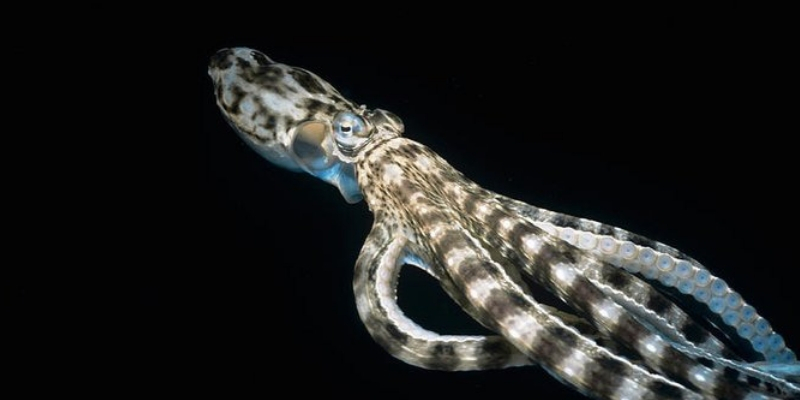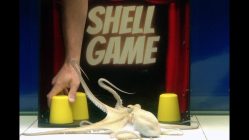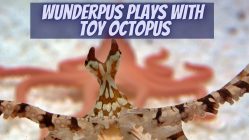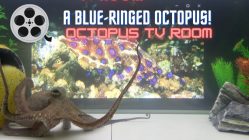
The mimic octopus — known as Thaumoctopus mimicus to its marine biologist friends — is a species of octopus that is found in the waters of the Indian Ocean as well as the central and western portions of the Pacific Ocean.
Mimic Octopus Facts
- Scientific Name : Thaumoctopus mimicus
- Common Name: Mimic Octopus
- Size: about 60 cm (2 ft)
- Weight: 0,5 kg
- Lifespan: 2 years
- Found in: Indo-Pacific seas
- Sub-Order: Incirrina
- Discovered: 1998
- Scientific Name : Thaumoctopus mimicus
- Common Name: Mimic Octopus
- Size: about 60 cm (2 ft)
- Weight: 0,5 kg
- Lifespan: 2 years
- Found in: Indo-Pacific seas
- Sub-Order: Incirrina
- Discovered: 1998
This species is known primarily for its ability to alter its color and shape to mimic that of other sea animals.
— Size and Appearance —
The mimic octopus is relatively small. They normally grow to be about two feet in length. Their eight arms are eight to ten inches in length with a diameter of approximately one inch.
In its natural state, the mimic octopus has a white and brown coloring that is distributed in a varied pattern throughout its body. This color distribution often times takes on the shape of stripes or spots.
Above their eyes, mimic octopi have small protrusions which resemble tiny horns.
— What Makes the Mimic Octopus So Special —
Seen in its generic state, the mimic octopus might appear to be just another run of the mill small octopus. However, when observed in its natural habitat going about its daily routine, your impression of the mimic octopus is bound to change.
It is for good reason that this species of octopus is colloquially known as the mimic octopus. That is exactly what it does to great effect. It is literally able to alter its coloration and shape to mimic other animals that share its habitat. Among the animals that the mimic octopus can “impersonate” are jellyfish, sea snakes, flatfish, and lionfish. All told, individual mimic octopuses have been observed to have the ability to mimic as many 18 different sea creatures.
Marine biologists have not fully cataloged all of the animals that the mimic octopus can imitate. It is believed that the range of animals that the mimic octopus can emulate varies depending on the immediate area which a single specimen inhabits. In other words, depending on what other sea creatures are their neighbors, those are the species that the mimic octopus will “assume.”
The mimic octopus not only takes on the general shape and coloration of those animals, but it is also able to mimic their movements and behavior. The mimic octopus doesn’t just try to blend in — it acts like the animal that it is mimicking. Think of them as the “Rich Little” of octopi.
When marine biologists first discovered this species of octopus in 1998 they were impressed by its “shapeshifting” abilities. There are no other species of octopus which can do what the mimic octopus does. Yes, there are many octopi species which are adept at camouflaging themselves into the background of their respective habitats by changing pigmentation, but none come close to what the mimic octopus does.
— Is This Mimickery Purely Instinctual or is It Learned? —
The debate is still open in the marine biology community as to how the mimic octopus hones its natural talent. While the ability to morph in appearance to emulate other creatures is certainly the result of natural selection and evolution, the way in which the mimic octopus puts this ability to use does spark some interesting questions. How does it select which animals to emulate? How are they able to customize this ability to different regions with different local fauna? Is this an indication that individual observation and learning on the part of the octopus might be involved?
It is possible that the mimic octopus uses passive observation of local fauna to better mimic those creatures. Imagine a method actor studying a subject and slowly adjusting their performance to portray them with acute realism. Now transpose that to a mimic octopus camouflaged on the sea bottom watching one of its predators or competitors and using that cognitive input to improve its portrayal of that animal. That would be amazing, wouldn’t it? Maybe one day a mimic octopus could be nominated for an Academy Award.
— Ways the Mimic Octopus Leverages Its “Mimickery” —
Due to the fact that the mimic octopus can mimic a variety of different creatures, it is able to use this ability in a much more diverse way than other animals which use coloration solely for survival through camouflage. Those other animals use pigmentation manipulation and transformation to blend in — to try and go unnoticed by predators or to lay in wait for potential prey to approach them. Think along the lines of a chameleon.
While the mimic octopus can use its ability to camouflage itself into its surroundings just like other color-shifting creatures, it is able to “up” its game to a much higher level. By emulating the movement and behavior of another creature, the mimic octopus is able to take active actions in its defense as well as to improve its performance as a predator.
— Are Mimic Octopi on the Cutting Edge of Evolution? —
Some classify the unique adaptation of the mimic octopus as being one which is actively used by the individual octopus for a tactical gain —not just a natural strategic advantage. This would be similar to how opposable thumbs were used by our ancestors for improved tool building which in turn resulted in larger brains and improved cognition. Could this be happening with the mimic octopus due to this adaptation? Are they more cognitive than other octopi? Could they be developing a rudimentary form of sentience?
Those questions are definitely interesting and provoke thought. It also helps to fuel the mystery and debate about octopuses in general. Just how smart are they? What other species of octopi are out there that could impress us even more?
— In Any Shape or Form, the Mimic Octopus Is Interesting —
Whether you are a marine biologist, a sea life enthusiast or an ordinary observer of nature — the mimic octopus is clearly one of the most amazing creatures that share our planet. The more we study and observe this species, the more that we will earn about the nature of octopi and all cephalopods in general.
















